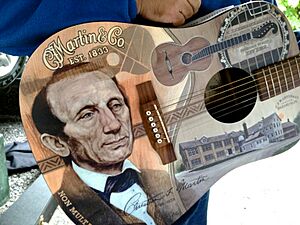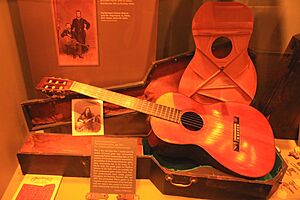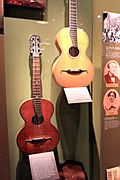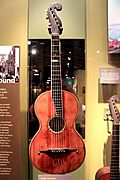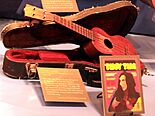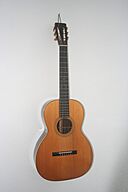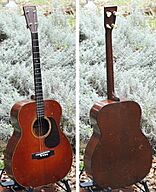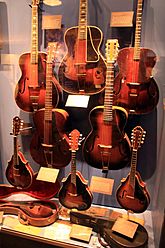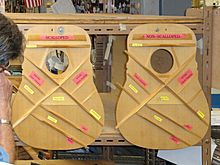- This page was last modified on 17 October 2025, at 10:18. Suggest an edit.
C. F. Martin & Company facts for kids
 |
|
| Industry | Musical instruments |
|---|---|
| Founded | 1833 in New York City; relocated to Nazareth, Pennsylvania in 1838 |
| Founder | Christian Frederick Martin |
| Headquarters |
,
United States
|
|
Key people
|
Christian Frederick Martin IV (Executive Chairman); Thomas Ripsam (CEO) |
| Products | |
C.F. Martin & Company, often called Martin, is a famous American company that makes guitars. It was started in 1833 by Christian Frederick Martin. The company began in New York City. After six years, it moved to Nazareth, Pennsylvania, in 1839.
Martin is well-known for its amazing acoustic guitars. It is a top maker of flat top guitars and ukuleles. In the past, the company also made mandolins, tiples, electric guitars, and electric basses.
The first factory in Nazareth is now a store for guitar makers. It was added to the National Register of Historic Places in 2018. The main office today has the Martin Guitar Museum. This museum shows over 170 guitars made by the company. Visitors can see pictures of famous guitar players. They can also try and buy guitars, or take a tour of the factory.
Martin makes many types of instruments. These include steel-string, classical, and acoustic guitars, plus ukuleles. The company also makes instruments and strings in Navojoa, Mexico. They produce about 193 guitars every day. Many famous guitarists have used Martin Guitars. These include Johnny Cash, Elvis Presley, Bob Dylan, John Lennon, Kurt Cobain, and Eric Clapton.
Contents
History of Martin Guitars
How Martin Guitars Started
Christian Frederick Martin was born in 1796. He grew up in a small German town called Markneukirchen. This town was famous for making musical instruments. Christian came from a family of woodworkers. His father also built guitars.
When he was 15, Christian became a student of Johann Georg Stauffer. Stauffer was a well-known guitar maker in Austria. After his training, Martin went back home. He opened his own guitar-making shop. Soon, he faced a problem with two groups of craftsmen called "guilds."
In the early 1800s, craftsmen in Europe worked under a guild system. Most guitar makers belonged to the Cabinet Makers' Guild. But the Violin Makers' Guild said only they could make musical instruments. They tried to stop cabinet makers from building guitars. Even though the cabinet makers won, Christian Frederick Martin felt the guild system was too strict. So, he moved to New York City in 1833.
Moving to Pennsylvania
Five years later, in 1838, Martin moved his company. He chose Nazareth, Pennsylvania, as its new home. The company has been there ever since.
How Martin Guitar Styles Changed Over Time
New York Style:
Guitars made in New York City.
Guitars made in New York City.
Nazareth Style:
Guitars made in Nazareth, Pennsylvania.
Guitars made in Nazareth, Pennsylvania.
Martin is known for creating the X-bracing system in the 1850s. This is a special way to support the top of the guitar. It helps the guitar sound better. Martin was the first company to use X-bracing a lot. This method helped American guitars get ready for steel strings. Steel strings became popular in the early 1900s.
Martin also used a special joint called a dovetail joint. This joint connects the guitar's neck to its body. Many people believe this helped the sound travel better from the neck to the body.
New Strings and Ukuleles
In the early 1900s, guitars became very popular. People wanted louder guitars. So, many companies started using metal strings instead of traditional animal gut strings. These were called steel-string guitars. By 1921, Martin focused on making steel-string guitars.
Martin Soprano Ukulele, played by Tiny Tim.
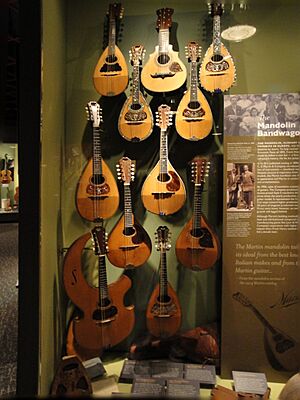
A display of Martin mandolins.
Martin's reputation grew. They started making mandolins in the late 1890s. Then, in the 1920s, they began making ukuleles. Making ukuleles helped the company stay strong and profitable during the 1920s.
By 1928, Martin was making over 5,000 instruments each year. The company remained family-owned. It had a small team of skilled craftsmen. They made instruments mostly by hand. By the early 1960s, people had to wait up to three years for a Martin guitar. This was because they could not make them fast enough. In 1964, Martin opened a new factory. This factory is still the main place where Martin guitars are made today.
Innovations During Tough Times
The Great Depression in 1929 hurt Martin's sales. The company came up with two new ideas to help business.
An example of an early 12-fret guitar from 1907.
A Martin tenor guitar from 1933 with a 14-fret neck.
One idea was the 14-fret neck. This neck allowed players to reach higher notes more easily. Most guitars at that time had necks joined at the 12th fret. Martin wanted to attract banjo players to switch to guitar. This new design became very popular. Martin made the 14-fret neck standard on almost all its guitars. Other guitar companies soon copied this idea.
The Dreadnought Guitar
Martin's second big idea was the dreadnought guitar. This guitar was first made in 1916. It was a team effort between Martin and a store called Oliver Ditson Co. The dreadnought body was much larger and deeper than other guitars.
The name "Dreadnought" came from a very large Royal Navy battleship launched in 1906. This ship was so big it had "nought to dread" (nothing to fear). Martin used this name for their new, large guitar. The bigger size made the guitar louder. It had a stronger bass sound. This made it better for singers who had limited sound equipment.
In 1931, Martin brought back the dreadnought with X-bracing. Two years later, they changed its body shape for the 14-fret neck. It quickly became their best-selling guitar. The "dreadnought" size and shape became a standard for acoustic guitars. It is now famous for its use in many types of music.
Martin in the 1960s
In the late 1960s, Martin made hollow-body electric guitars. These were similar to guitars made by Gretsch. But Martin's electric guitars were not very popular. Since then, the company has mostly made acoustic guitars. They also brought back the famous D-45 model in 1968.
Many musicians in the 1960s preferred Martin guitars made before World War II. These older guitars had a different internal bracing. This bracing helped them sound better. Also, their tops were made from a special wood called Adirondack red spruce. Newer guitars used Sitka spruce.
After 1969, Martin started using Indian rosewood for some guitar parts. This was because there were rules about selling Brazilian rosewood. Older D-28s and D-35s from the mid-1960s are now very valuable.
- Martin Dreadnought size guitars
-
Martin D-42 Johnny Cash Signature
Stinger Guitars
Stinger guitar headstock.
A Stinger SWG guitar.
From 1985 to 1996, Martin made electric guitars and basses called Stinger. These guitars looked like Fender guitars. They were made in South Korea. Then, they were sent to the Martin factory for checking and final setup.
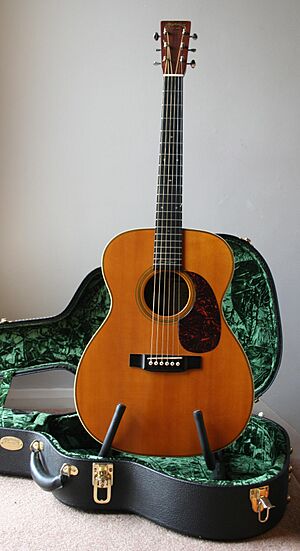
The C.F. Martin 000-28EC Eric Clapton model guitar.
Martin started its "Custom Shop" in 1979. This is where special, custom-made guitars are built. In 1990, Martin built its 500,000th guitar. In 2004, they built their millionth guitar. This millionth guitar was made completely by hand. It had over 40 rubies and diamonds. It was worth about $1 million. As of 2007, Martin had 600 employees.
Martin in the 21st Century
In October 2009, Elvis Presley's D-28 Martin guitar was sold. He played it at his last concert. It sold for $106,200 at an auction.
To reach more customers, Martin started making guitars with laminated wood in 1993. These were the D1 series. They had laminated wood sides and a solid wood back. Later, they made an even cheaper DX series. These guitars use special laminated materials. They are built at Martin's factory in Mexico. They still have great sound quality.
In January 2018, Martin announced a D-45 John Mayer signature model. This special guitar was shown at the NAMM Show.
In 2018, Martin hired Greg Koch. He became a Martin guitar ambassador. He now shows off Martin guitar models at events.
On June 21, 2020, a 1959 Martin D-18 E guitar was sold. This guitar was changed so it could be plugged into an amplifier. Kurt Cobain played it during Nirvana's 1993 MTV Unplugged show. It sold for $6,010,000. This was a record price for any guitar.
On August 1, 2020, a D-18 guitar owned by Elvis Presley was sold. He used it from December 1954 to May 1955. It sold for US$1,320,000. This was the highest price ever paid for an acoustic guitar that was not changed.
The Martin family has always run the company. The current Executive Chairman, C.F. 'Chris' Martin IV, is the great-great-great-grandson of the founder. Martin was the first company to introduce many features of modern acoustic guitars. These include the Dreadnought body style and scalloped bracing. In June 2021, C.F. Martin IV stepped down as CEO. He is still the Executive Chairman on the Board. Thomas Ripsam became the first CEO who is not a family member.
See also
 In Spanish: C.F. Martin & Company para niños
In Spanish: C.F. Martin & Company para niños
- List of music museums

